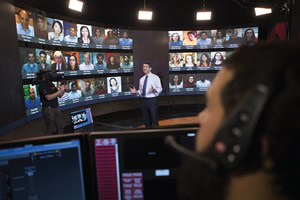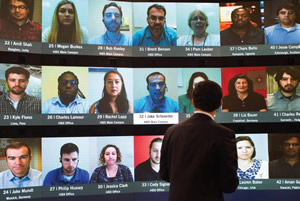AV Innovations for Today’s Classrooms

PHOTO COURTESY OF MCCANN SYSTEMS
The educational landscape is always changing, and one of the most impactful trends of the modern age is the continuous development of new audiovisual (AV) technologies that allow educators to engage students more deeply and enhance remote learning with seamless audio and video communications. For all forward-thinking institutions, outfitting classrooms and other spaces with the latest technologies is an important way to attract tech-savvy students, improve learning, and provide educators with more effective teaching tools. Here, we examine how innovative technology installations at large and small U.S. colleges are benefiting students and educators.
Improving Flexibility and Communication
Students learn in different ways. There is a growing school of thought that the current generation of students, having grown up surrounded by high-definition, internet-connected technologies, may learn more effectively with “personalized” options, including remote or hybrid courses that offer the benefits of digital face-to-face interactions.
At Purdue University in Indiana and the University of Idaho, faculty are utilizing new microphone and video camera technologies to elevate the distance-learning experience. Beamforming microphone arrays, now found in several Purdue classrooms, combine multiple centralized microphones with artificial intelligence to ensure the clearest audio possible for students tuning in remotely. The system can automatically detect where sound is coming from and choose the ideal combination of microphones to use, creating a “beam” of coverage to best capture audio from that part of the room.
The University of Idaho recently began using a 4K panoramic videoconferencing camera that combines video from three lenses to create a 180-degree field-of-view, providing wall-to-wall coverage in even the smallest huddle rooms. Some of the cameras are permanently stationed in classrooms, while others are available for faculty to borrow and use wherever they need to. Since they have stereo microphones, a plug-and-play USB port, and are compatible with all the leading videoconferencing software, they can be used immediately with any computer. The new tech has enabled professors to conduct remote classes, meetings, and even office hours from a variety of locations, all while helping the distance participants see everything that’s happening within the classroom and thus feel more like they are part of the action.
Providing Complete Control of Interactive Classrooms

PHOTO COURTESY OF MCCANN SYSTEMS
At Utah’s Salt Lake Community College (SLCC), several new Flex classrooms show how smaller colleges can develop innovative learning environments. Each Flex classroom includes multiple high-definition video projectors that work with special wireless annotation pens to enable digital manipulation and interaction with projected materials. Students and faculty can take notes directly on the projected content, then save the results as new files to take with them.
The school set a policy of only purchasing projectors with brightness of 6,500 lumens and higher, citing the need for clear, extra-large images in any lighting environment. Its choice to invest in more expensive laser-based models eliminates the need for bulb replacements, and thereby reduces maintenance costs and ensures every projector is ready for every class. The projectors also feature wireless technology that enables faculty and students to stream content from their mobile devices or laptops.
Reaching 1,000 Remote Students at Once
Harvard Business School in Boston is raising the stakes on virtual interactive learning with its transformative HBX Live program. HBX Live adopted leading practices from the media production industry to reach every corner of the globe in real time and deliver a unique education experience that puts each learner at the center of the class.
HBX Live broadcast studio uses a 4.5-meter-by-8.2-meter curved video wall to display the webcam feeds of up to 60 learners, simulating a true classroom-like layout in front of the professor. The studio classroom, leased from local station WGBH, involves four production staffers to manage videography from six in-studio cameras as well as incoming audio and video from 60 remote laptops.
To further simulate real-time classroom interaction, loudspeakers are concealed within the video wall. If the professor is engaged in conversation with a learner on one end of the video wall, but a learner on the opposite end interjects, there’s a spatial audio cue that signals the interjection—just as if in a classroom.
It’s a technological feat to reach 60 live students simultaneously, but HBX Live can actually host up to 1,000 viewers with just a 15-second delay. Although many vendors told Harvard Business School that existing technologies couldn’t satisfy their expectations, a New Jersey-based integrator, McCann Systems, was able to use new technologies to create the final custom platform that has been wowing students and faculty alike for the past three years. This proves that with the right technology partners, even the seemingly impossible is possible.
There’s no one-size-fits-all technology system that is ideal for every school, situation, or curriculum, but the variety of inventive products and solution providers, combined with schools’ desire to create new learning environments, bodes well for the future of higher education. Through audiovisual integration, colleges and universities can increase flexibility for students, faculty, and campus infrastructure usage while improving classroom engagement with interactive lessons and lectures. The only question now is which school will usher in the next great innovation in education.
This article originally appeared in the College Planning & Management June 2019 issue of Spaces4Learning.
About the Author
Brad Grimes is senior director of Communications for AVIXA, the Audiovisual and Integrated Experience Association. AVIXA represents the $178 billion global commercial AV industry and produces InfoComm trade shows around the world. For more information, visit www.avixa.org/higheredAV.